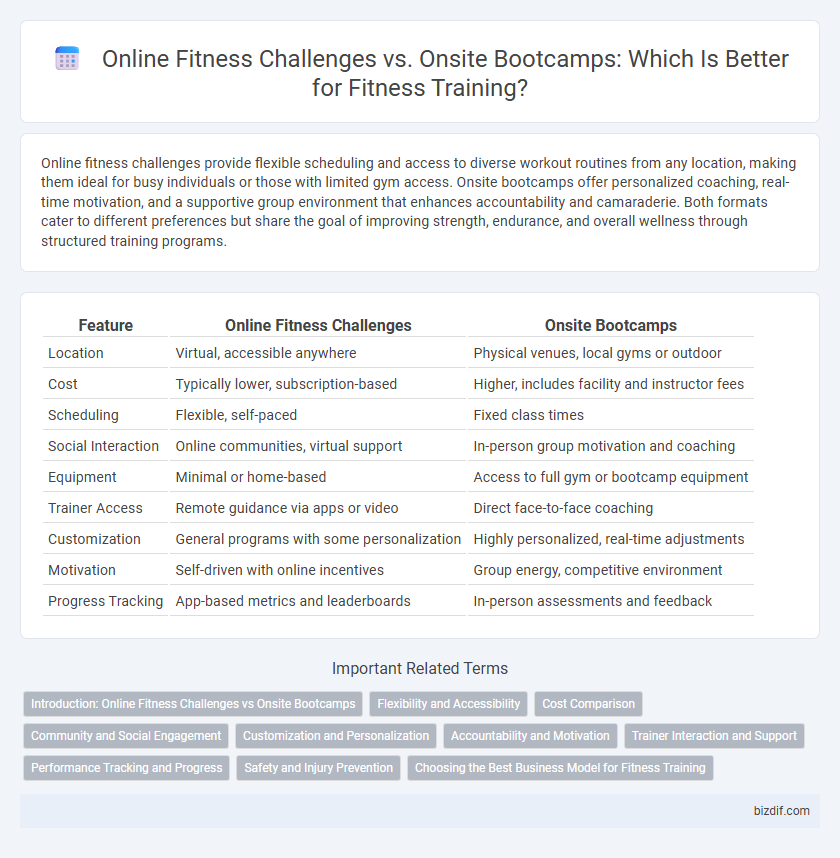Online fitness challenges provide flexible scheduling and access to diverse workout routines from any location, making them ideal for busy individuals or those with limited gym access. Onsite bootcamps offer personalized coaching, real-time motivation, and a supportive group environment that enhances accountability and camaraderie. Both formats cater to different preferences but share the goal of improving strength, endurance, and overall wellness through structured training programs.
Table of Comparison
| Feature | Online Fitness Challenges | Onsite Bootcamps |
|---|---|---|
| Location | Virtual, accessible anywhere | Physical venues, local gyms or outdoor |
| Cost | Typically lower, subscription-based | Higher, includes facility and instructor fees |
| Scheduling | Flexible, self-paced | Fixed class times |
| Social Interaction | Online communities, virtual support | In-person group motivation and coaching |
| Equipment | Minimal or home-based | Access to full gym or bootcamp equipment |
| Trainer Access | Remote guidance via apps or video | Direct face-to-face coaching |
| Customization | General programs with some personalization | Highly personalized, real-time adjustments |
| Motivation | Self-driven with online incentives | Group energy, competitive environment |
| Progress Tracking | App-based metrics and leaderboards | In-person assessments and feedback |
Introduction: Online Fitness Challenges vs Onsite Bootcamps
Online fitness challenges offer flexible, accessible workout plans that participants can follow from any location using digital platforms and mobile apps. Onsite bootcamps provide structured, high-intensity group training sessions led by certified instructors in physical settings, fostering immediate motivation and social interaction. Both approaches target improved physical fitness but differ in engagement style, environment, and accountability mechanisms.
Flexibility and Accessibility
Online fitness challenges offer unmatched flexibility, allowing participants to train anytime and anywhere, accommodating diverse schedules and time zones. Onsite bootcamps provide structured environments with direct instructor guidance but require physical presence, limiting accessibility for those with location or mobility constraints. Digital platforms enhance accessibility by providing a wide range of programs suitable for various fitness levels, making workouts convenient without the need for commuting.
Cost Comparison
Online fitness challenges typically offer a more cost-effective option, with prices often ranging from $10 to $50 per month, compared to onsite bootcamps that can cost between $150 and $500 per session. Virtual programs eliminate expenses related to travel, equipment, and facility fees, providing affordable access to expert trainers and structured workouts. Budget-conscious participants find online challenges more accessible, while onsite bootcamps deliver in-person guidance at a higher price point.
Community and Social Engagement
Online fitness challenges foster a global community where participants connect through digital platforms, enabling continuous social engagement and motivation regardless of location. Onsite bootcamps create strong local bonds through face-to-face interactions, promoting accountability and real-time camaraderie. Both approaches enhance community support, but onsite bootcamps offer a more immersive social experience, while online challenges provide flexibility and broader accessibility.
Customization and Personalization
Online fitness challenges offer tailored workout plans and nutrition guidance based on individual fitness levels and goals, utilizing algorithms and user data for precise customization. Onsite bootcamps provide real-time personal coaching and immediate adjustments, allowing trainers to customize exercises according to participants' form and performance feedback. Both methods enhance personalization, but online challenges leverage technology for scalable customization while bootcamps emphasize hands-on, adaptive training.
Accountability and Motivation
Online fitness challenges leverage digital tracking tools and community forums to enhance accountability, allowing participants to monitor progress and receive real-time feedback, while onsite bootcamps foster motivation through face-to-face interaction, immediate coach correction, and group energy. Research shows that physical presence in bootcamps can boost participant commitment and enthusiasm, whereas online challenges offer flexible schedules that accommodate varied lifestyles. Combining both approaches maximizes motivation and accountability by balancing personalized support with adaptable engagement.
Trainer Interaction and Support
Online fitness challenges offer flexible access to trainer guidance through live chats, video calls, and personalized feedback, enabling continuous support regardless of location. Onsite bootcamps provide direct, in-person interaction with trainers, allowing real-time corrections, motivation, and hands-on assistance that enhance exercise form and safety. Both formats emphasize trainer support, but onsite bootcamps deliver immediate physical presence, while online challenges leverage digital tools for consistent remote engagement.
Performance Tracking and Progress
Online fitness challenges leverage digital tools for real-time performance tracking, enabling participants to monitor progress through apps and wearable devices that provide detailed metrics such as heart rate, calories burned, and workout intensity. Onsite bootcamps offer immediate, hands-on feedback from trainers who can adjust form and technique in person, enhancing performance through direct supervision and motivation. Both integrate performance tracking and progress assessment but differ in the immediacy of feedback and the level of personalized guidance available.
Safety and Injury Prevention
Online fitness challenges offer customized workout plans with guided video instructions, reducing the risk of injury by allowing participants to exercise at their own pace in a controlled environment. Onsite bootcamps provide direct supervision from trainers who can correct form and immediately address improper techniques, enhancing safety during high-intensity exercises. Both formats emphasize injury prevention, but onsite bootcamps benefit from professional oversight, while online challenges leverage flexibility and digital monitoring tools.
Choosing the Best Business Model for Fitness Training
Online fitness challenges offer scalable, low-overhead options attracting a global audience with flexible scheduling and real-time tracking features. Onsite bootcamps provide personalized coaching and immediate social motivation, fostering community engagement and higher accountability. Selecting the best business model depends on target market size, available resources, and desired client interaction level for sustainable growth.
Online fitness challenges vs Onsite bootcamps Infographic

 bizdif.com
bizdif.com